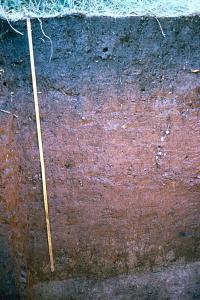Reference soil Mozambique 05: Phaeozem
Phaeozems occur all over the world, but especially on the more moist side of the steppe regions, bordering Chernozems.
Characteristics
Soils having a mollic horizon (deep, brownish or blackish surface horizon with a significant accumulation of organic matter and high base saturation); a base saturation of 50 percent or more between 25 and 100 cm from the soil surface; a calcium carbonate-free soil matrix at least to a depth of 100 cm from the soil surface, or to a contrasting layer between 25 and 100 cm; no diagnostic horizons other than an albic, argic, cambic or vertic horizon, or a petrocalcic horizon in the substratum.
Reference soil MZ005: Phaeozems
Brief description of the profile: A deep, well drained, dark reddish brown clay soil, strongly or moderately structured; with a thick dark coloured topsoil; subsoil aggregates fall apart when wetted. Soil when dry has a few cracks, width is less than 0.5 cm. Soil clods fall apart in very fine angular aggregates when saturated with water. At a depth of about 70-100 cm a "stone layer" is present with a thickness of 5 to 15 cm, containing few, fine to medium, iron rich angular concretions and few quartz gravels; the layer forms no limitation for root development. Land use: at site nearly permanently cultivated plots of smallholders, nearby large cotton estates.
